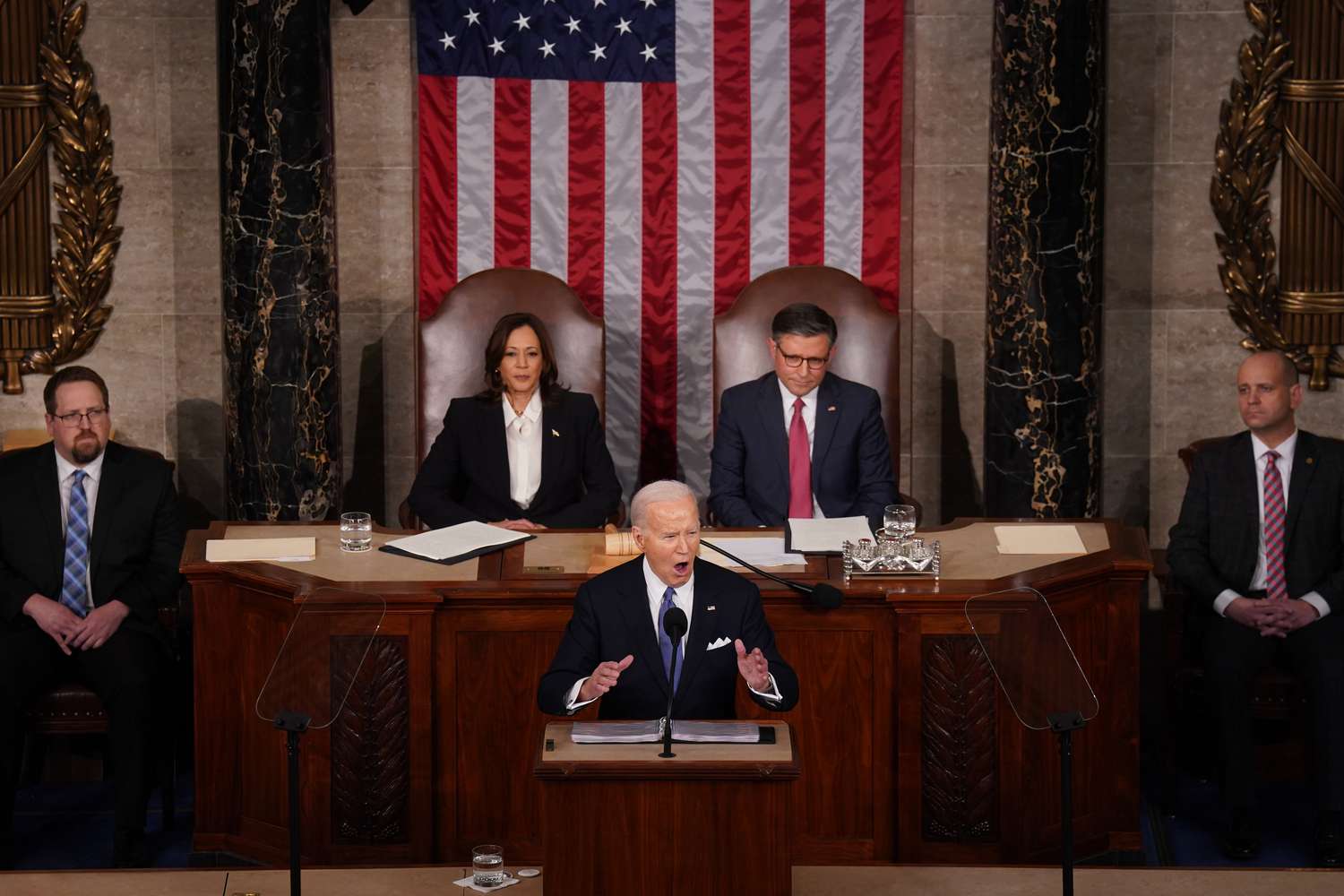Being a marketer and content creator, I’m frequently asked about the significance of content creation in marketing. Content creation is the driving force behind the scenes, enabling Google to provide the perfect solution with a blog or website link. It encompasses the videos we watch on YouTube as a form of relaxation. You won’t find any judgment here—I do it too.
Moreover, content creation plays a vital role in promoting your business, brand, and products. Compelling content attracts, engages, and delights both prospects and customers, leading to increased website traffic and ultimately generating revenue for your company. In simple terms, if you’re not creating content, you’re falling behind the curve.
What is content creation?
Content creation involves generating compelling topic ideas that resonate with your target audience, crafting well-crafted written or visual content based on those ideas, and effectively presenting that information to your readers in various formats such as blogs, videos, infographics, and more. This process requires careful attention to word choice, structure, readability, and eloquence to ensure maximum impact and engagement while staying true to the original message.
Why is content creation important?
Content creation stands as the ultimate practice in inbound marketing. By providing my audience with valuable and free information, I attract potential customers to my website and foster lasting relationships with existing ones through quality engagement. Moreover, I generate significant value for my company. Need proof? Consider these compelling statistics:
– Approximately 50% of marketers plan to increase their investment in content marketing by 2024.
– Nearly 40% of marketers regard content marketing as essential to their overall marketing strategy.
– Additionally, 10% of marketers who engage in blogging claim it yields the highest return on investment.
Content equals business growth. So, let’s begin by exploring the various types of content you can create and then evaluate your content strategy.
Types of Content Creation
Blogs
One form of content creation is the very one you are currently engaging with — blog posts! Blogs have the power to educate, entertain, and inspire your audience through the written word.
When individuals enter a query into Google, the search results often consist of blog posts.

Blogging is truly a worthwhile endeavor, and I’m not biased just because I’m a blogger myself. According to recent surveys, 56% of marketers consider blogging as their most impactful content strategy. Moreover, it’s interesting to note that blogging ranks among the top media formats that marketers are planning to embrace for the first time in 2024. So, investing time and effort into blogging can undoubtedly yield significant benefits for individuals and businesses alike.
Content Creation Ideas for Blogs
1. Answer a Question
One of the articles I write for my column, “The Creative,” tackles a common concern among novice content creators: how and when to pursue brand collaborations. Reflecting on the questions I had when I was starting out, as well as those from my recent experiences, can provide valuable insights to others in the industry. By crafting a blog post that addresses these inquiries, you not only establish trust with your audience but also enhance your search engine rankings.
2. Compare and Contrast Solutions to a Problem
If you possess expertise in your niche, you have the opportunity to offer valuable insights while assisting readers in making well-informed decisions. For instance, in one of my recent blog posts, I delved into a comprehensive comparison between influencers and creators, aiding marketers in determining the most effective strategy to leverage.
When crafting compare and contrast blogs for products, services, or methods, it is imperative to prioritize transparency and openness. Enlist all potential positives and negatives, leaving no stone unturned. Subsequently, elaborate on the process behind reaching those conclusions, providing readers with intricate details.
3. Teach Something
If you intend to utilize your blog as an effective teaching tool, there are several key considerations to keep in mind. When selecting a topic, it is prudent to start small. Rather than attempting to cover a broad range of subjects, opt for a niche topic that is relevant to your industry and likely to be of interest to your readers.
For instance, the blog post provided below does not attempt to encompass every aspect of blogging. Instead, it offers readers a comprehensive, step-by-step guide to the art of blog writing. By narrowing the focus and providing valuable insights, you can create a more impactful and engaging blog that resonates with your audience.
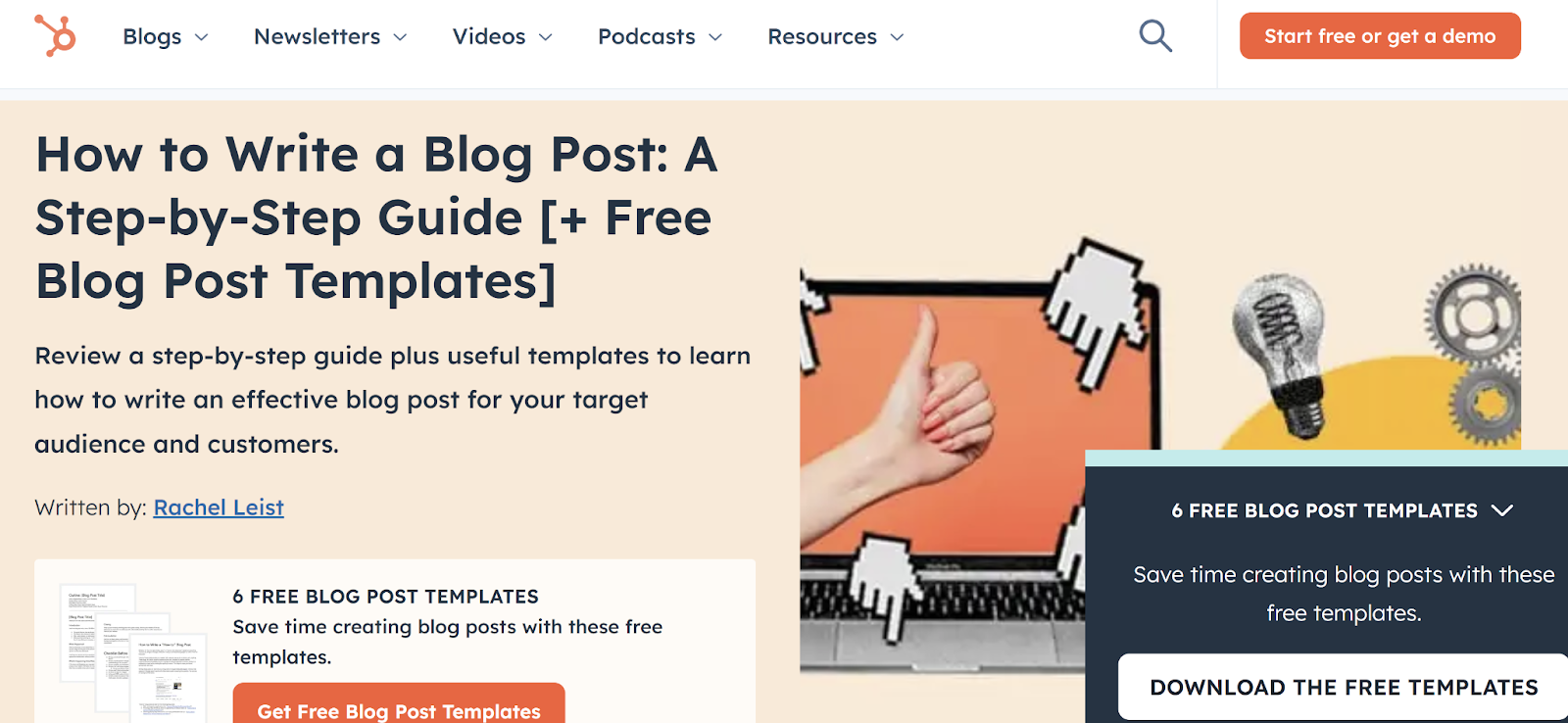
When writing how-to blogs, keep a few key points in mind:
– Utilize concise sentences and paragraphs, while maintaining a clear and logical structure. This will enhance the comprehensibility of your instructions.
– Avoid using technical jargon and terms, instead, employ examples to facilitate understanding of new information.
– Always remember that your directions should cater to beginners. Avoid skipping steps or offering shortcuts.
By implementing these tips, you can enhance the learning experience for your readers, driving more traffic and generating interest in your educational content.
4. Daily, Monthly, or Weekly Series
Crafting a series of posts can prove invaluable to your readers and foster blog growth. Typically spanning a defined period, you have the flexibility to publish the series daily or on a selected day each week or month.
Moreover, a series presents an opportunity to repurpose content effortlessly across various platforms. For instance, if your blog centers around social media, transforming a blog series on Instagram Reels into a podcast, ebook, or video becomes a seamless endeavor.
This strategic approach facilitates comprehensive exploration of specific topics, while also enhancing the construction of internal and external links, positioning you as a trusted authority.
5. Quizzes and Surveys
Utilizing blog surveys is an excellent method for gathering valuable feedback from your audience. Not only can this assist in boosting website traffic, but it also offers a multitude of other advantages. By analyzing responses from quizzes and surveys, you can gain insights into the types of content that resonate with your audience, make informed decisions on which products to promote and sell, expand your social media following, Create engaging interactive content that has the potential to go viral, and proactively anticipate customer service issues. To ensure an effective quiz or survey, it is crucial to establish clear goals before embarking on the creation process. Additionally, keeping your quizzes concise and offering incentives can substantially enhance response rates.
6. Curated Content for Target Audiences
Curating content has the power to make your valued audience feel truly important. This, in turn, can transform them into enthusiastic promoters who eagerly share your content and inspire others to invest in your products.
Crafting curated content specifically tailored to your audience is key. Take, for instance, marketing professionals as our target audience. It is for them that we create valuable and relevant content.
To curate content effectively, begin by developing detailed buyer personas and conducting thorough competitor research. With these insights, create content clusters that cater specifically to each buyer persona.
Curated content provides the perfect opportunity to showcase quotes and insights from industry leaders. It should not only inform your targeted audience but also make them feel like they are part of an exclusive community.
If you are seeking assistance in curating your content, be sure to explore this helpful list of tools.
7. Celebrate Wins
Blogs, known for their evergreen nature, have the incredible ability to serve as valuable resources for years to come once published on the internet. This unique characteristic of blogs makes them an ideal platform to commemorate achievements and successes.
Whether it’s acknowledging exceptional employees or expressing gratitude towards customers, your blog can become a hub for celebrations. It’s important to remember that even the smallest victories deserve recognition. Enhance the impact of your celebration posts by incorporating captivating images, engaging videos, and thoughtful designs to make them truly extraordinary.
Podcasts
Podcasting has become accessible to everyone, allowing both seasoned professionals and aspiring hosts to vie for listeners’ attention. With a substantial audience, as many as 28% of Americans aged 12 and above tune in to podcasts on a weekly basis. The allure of podcasts lies in the bond that forms between the audience and the host, driven by a genuine desire to learn from and connect with them. Discover a plethora of captivating podcast content creation ideas as you delve deeper into this article.
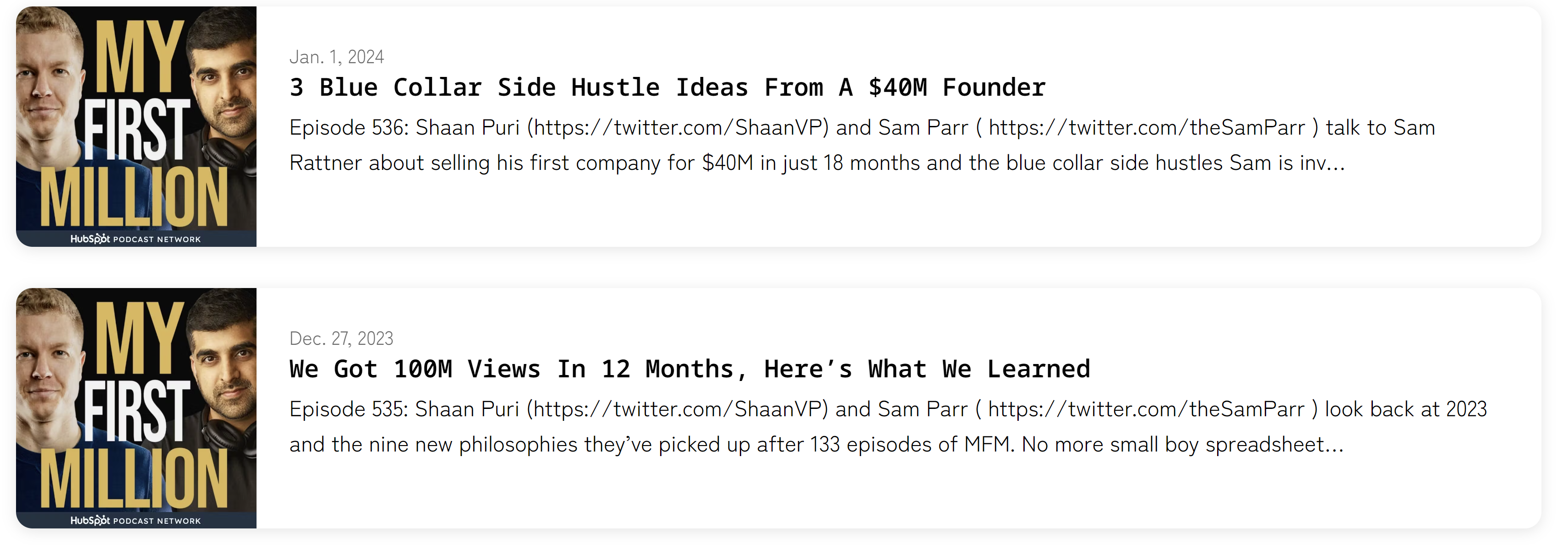
Image source
A remarkable podcast typically revolves around a captivating concept, amplifying its essence through input from listeners and experts. Storytelling and educational podcasts have gained significant popularity in recent times.
When embarking on your inaugural podcasting journey, ensure a consistent posting schedule, while adhering to a uniform structure for each episode. Beyond that, the key lies in embracing your authentic self, allowing your unique personality to shine through.
Content Creation Ideas for Podcasts
1. Thought Leadership
Create podcast content that focuses on your professional experience. Incorporate case studies and real-life scenarios to engage your audience. Keep in mind that your listeners have varying levels of industry experience, so provide insights that cater to a wide range of listeners. Share practical advice that your audience can easily apply in their own lives.
2. Interview Influencers
When it comes to adding influencer interviews to your podcast, the first step is to know who to interview. Instead of solely focusing on big names, prioritize interesting guests who can provide value to your listeners.
For my podcast, “Nerds @ Work w/ TsundEri,” I carefully consider the story I want to tell and choose guests who are best suited to share that story. Thoroughly researching your guests and asking unique questions is crucial. As a podcaster, one of the biggest compliments I’ve received is that my interviews are well-researched, demonstrating my commitment to understanding the work my guests do.
This level of dedication shines through in the content and helps ensure that guests will not only want to return in the future but also recommend their colleagues for interviews. To maximize the impact of influencer interviews on your podcast, consider asking for follower suggestions and encouraging participation from the featured influencer’s audience.
3. Discuss Trends
Podcasts thrive on trends, whether it’s a long-term shift or the latest craze. This provides a clever context to showcase how your products remain relevant to what’s new. While daily or weekly news podcasts attract many listeners, most podcasts have an evergreen nature akin to blogs.
Surprisingly, podcast enthusiasts often listen to episodes released years ago. This highlights the importance of linking trends to broader subjects. For instance, the podcast “Marketing Against the Grain” delves into trends like the creator economy, but within the larger realm of marketing. This strategic approach grounds potentially fleeting trends in topics with enduring significance.
4. Contests and Giveaways
Podcast contests offer an enjoyable opportunity for your listeners to engage and help you expand your subscriber base. You can kick off a podcast contest by promoting a prize or giveaway on social media. Alternatively, interactive contests that allow listeners to call in and participate in the podcast can be an excellent choice. When offering a prize, ensure that it is distinctive and tailored to your specific audience.
Videos
Video marketing is a rapidly growing form of content creation that gains popularity year after year. Incorporating both short-form and long-form videos into your content creation strategy is essential. It is crucial to brainstorm ideas for both types of content.
An impressive 86% of video marketers affirm that video is highly effective in generating leads. Therefore, original video marketing is a crucial strategy for anyone focusing on content creation.
Some excellent ideas for video content include behind-the-scenes footage or captivating time-lapse videos. Let’s explore other valuable ideas to enhance your video content creation.
1. Use Animation
Animation is a powerful tool for simplifying new or intricate information. Incorporating animated videos into your content can effectively demonstrate how your product functions and address the specific problem it solves.
By selecting relatable scenarios that directly connect to your product, you can bring otherwise mundane topics to life. Whether you opt for digital animation or stop-motion, animation has the ability to make abstract concepts more accessible to the everyday user.
For instance, while tech products often resolve issues that average users don’t encounter daily, such as a broken API connection, imagine an animated video illustrating the repercussions of a home’s wireless network being disrupted. This scenario-based approach can greatly enhance the average user’s understanding of abstract ideas.
2. Repurpose Blog Content
Boost your video content by using the text from your top-performing blog as a captivating voiceover. Transform lengthy blog posts into an engaging video series by breaking down key points into bite-sized social media videos. Enhance user experience by incorporating videos into your blog posts, offering search engine visitors an alternative way to access the information they seek.
3. How-tos and Tutorials
Video formats are highly popular for presenting how-to content. To create a compelling instructional video, adhere to concise and specific steps. Ensure nothing is omitted, as overwhelming your viewers with extraneous information should be avoided.
Utilize straightforward visual steps to facilitate learning, and conclude with a clear call-to-action. Engaging with comments on these videos is also advisable. This demonstrates your accessibility for further inquiries and can inspire additional video concepts.
4. Product Demos and Unusual Use Cases
Product demos can greatly facilitate potential customers in understanding how to utilize your products effectively. Moreover, they provide you with an opportunity to share insights into your product design processes.
By showcasing the initial problem your product solved and how its solution evolved through the process, you establish a connection with your viewers. This connection fosters trust and increases the likelihood of their engagement with you and your products.
To make your product demo more captivating, consider presenting how your product functions in an intriguing manner. Take inspiration from Blendtec’s renowned “Will It Blend?” video series on YouTube. Instead of merely demonstrating the blender’s power, Blendtec incorporated inventiveness by seeking customer suggestions for each video. Moreover, they blended unconventional objects like cell phones, golf balls, or glow sticks, which added an unexpected twist.
Another effective strategy is to personalize your video content. Video product demos provide an excellent opportunity to establish a connection between individual customers and your products.
Image-based Content
When it comes to your blog or social media posts, incorporating original graphics can make a significant impact. Whether it’s infographics, photography, GIFs, memes, illustrations, or screenshots, these visuals can capture your audience’s attention like nothing else.
Creating this type of content often requires the expertise of a graphic designer or a design tool to ensure professional results. Among the various content types, businesses rely heavily on photo and image-based posts to boost audience engagement.
As you dive into visual content creation, it’s crucial to have a solid understanding of the fundamentals. These include mastering the essentials to create compelling and captivating visuals.
- Choose the right subject to illustrate your idea
- Think about composition
- Use contrast and color
- Keep it simple
Image-based Content Creation Ideas
1. Visual Storytelling
Visual content is an excellent tool for conveying stories quickly. When experimenting with storytelling, it’s important to remember the age-old adage: show, don’t tell.
For instance, let’s say you’re recounting the tale of surpassing a challenging sales goal. Instead of merely depicting a sales representative engaged in a phone conversation, imagine capturing that same individual conquering a towering mountain. By leveraging elements such as setting, attire, lighting, and motion, you can effectively amplify the action and drama within each scene of your images.
2. User-Generated Content
Your product enthusiasts are always seeking ways to engage. And there’s nothing quite like user-generated content to demonstrate your dedication to their opinions.
To encourage users to create and share content for your brand, extend an invitation for their active participation. A custom hashtag or social media contest can serve as an effective starting point. Additionally, email provides an excellent avenue for collecting customers’ photos, quotes, and stories.
However, it is crucial to obtain explicit permission before utilizing user-generated content. Equally important, ensure due credit is given to users for their valuable contributions.
Remember, nothing can sever your connection with a customer quite like utilizing their images without proper consent.
3. Infographics
Data visualizations have been proven to reduce errors and enhance learning and retention by up to 80%. If you want to incorporate infographics into your content creation strategy, consider these essential best practices:
1. Select data that resonates with your target audience.
2. Choose the most suitable graph or chart for your data.
3. Conduct thorough research.
4. Craft a simple visual narrative.
5. Avoid overwhelming with excessive data.
6. Ensure your key points are easily digestible and memorable.
And remember, if you’re still hesitant about using infographics, rest assured that your competitors have already caught on. A staggering 26% of marketers are already utilizing infographics, with an additional 15% planning to leverage their power for the first time in 2024.
4. Go Behind the Scenes
Delighting your readers with industry and product secrets can be both captivating and informative. It serves as a fascinating way to shed light on the intricacies of your product creation, packaging, and updates.
To craft captivating visuals that offer a glimpse behind the scenes, it all starts with a well-thought-out plan. Whether you’re sharing captivating snapshots of your manufacturing facility or documenting the nuances of an average day on social media, strive for an element of coolness.
Consider factors like lighting, composition, and attention to detail. After all, you wouldn’t want a remarkable product shot to be marred by an unsightly trash can or an intrusive warning sign in the background.
Yet, at the same time, endeavor to infuse your images with a sense of authenticity. Avoid the temptation to stage your photos in an overly pristine and artificial setting that feels detached from reality.
Content Offers
Content offers are another type of valuable content. These can come in the form of templates, whitepapers, worksheets, or ebooks that your visitors can download. By gating this content, meaning your audience needs to fill out a form and provide their email to access it, you can effectively generate leads.
Lead generation is a key metric for content success, with 67% of companies using it as their primary measure. To draw in new leads, it’s important to combine content creation efforts with content offers. The best lead magnets are those that solve urgent issues and provide lasting value to your target audience.
To be immediately useful to your users, a content offer should be specific and user-friendly. It should also showcase your deep understanding and expertise, offering value that aligns with your high standards.
By consistently delivering valuable content, you can keep your audience engaged and convert more leads into satisfied customers. Here are some content ideas to get you started.
Content Creation Ideas for Content Offers
1. Ebooks or White Papers
Many businesses begin their content offerings by creating long-form written content. Ebooks and white papers provide readers with a comprehensive understanding of a topic and offer solutions to pressing issues. Although creating ebooks can be challenging, leveraging existing content such as blogs can help streamline the process. Additionally, utilizing a well-designed ebook template can expedite production.
2. Original Research
Data is the driving force behind many businesses. However, not all businesses have the luxury of time or resources to gather the necessary data. But fear not! You possess the knowledge and network to compile research that your visitors can benefit from.
To create outstanding research, consider the following:
1. Clearly define your research goals.
2. Develop a robust process for sampling and analyzing data.
3. Craft relevant and insightful questions.
4. Implement an effective project management process.
It is crucial to estimate the time and resources required to complete your research. To streamline your efforts, consider using a market research template to organize and consolidate your findings.
Once your research is complete, the next step is to determine the optimal format and channels to present your stellar content offer.
3. Tools and Templates
A compelling content offer empowers your audience to solve problems quicker than if they were to tackle them alone. This is why tools like calculators, swipe files, and checklists are invaluable assets.
Moreover, your templates hold value not only in the present, but also for the future, as they continue to serve your fans. These valuable lead magnets not only allow you to assist your community, but also serve as remarkable resources for generating leads and creating brand advocates.
By providing a template that someone consistently uses, the likelihood of them sharing it with others increases. This makes content offers an excellent avenue for organic growth through word of mouth, one of the most trusted sources for consumers. In this way, content offers become a win-win situation.
While some templates and tools require advanced coding or technical knowledge, most are simple to put together. With tools like Microsoft Excel or Google Docs, which are widely used in everyday life, creating a template is a breeze.
As you embark on your creation journey, remember that usefulness trumps perfection. Focus on making something valuable rather than obsessing over appearance.
4. Kits and Workbooks
After gathering a selection of the aforementioned resources, you may find yourself ready to craft a comprehensive content offer. Kits and workbooks for this purpose typically consist of a variety of complementary resources. For instance, let’s say you’ve created various templates for social media captions across different platforms.
By combining these templates, you can create the ultimate social media caption kit. To prevent overwhelming your leads with information, it’s advisable to consider the structure. Breaking down your kit or workbook into easily digestible sections is a wise move. Additionally, incorporating graphics and other media elements can help break up dense blocks of text and maintain reader engagement.
A workbook or kit might also include:
- Worksheets
- A Q&A
- Checklists
- Schedules
- Journal prompts
Social Media Content Creator Ideas
Prior to joining HubSpot as a writer and marketer, I gained experience managing social media accounts for local news outlets. Trust me when I say that creating shareable social media content can be quite the challenge.
Each platform has its own unique characteristics, and not every post will yield the same results across all channels. Nevertheless, it remains an excellent method for engaging with and expanding your audience.
Luckily, I have a few ideas that not only helped me generate fresh social media content, but can also assist you in doing the same.
1. Share relevant industry news.
Having previously worked in local news, I gained valuable insights into the significance of delivering relevant content. Our audience sought more than just news; they craved information that directly related to their community, concerns, and industry. When it comes to incorporating news into your social media content, remember this key point.
Originality isn’t always a prerequisite for your brand’s social media posts. In fact, there are numerous advantages to sharing industry-specific content and news on your platforms. Firstly, it keeps your audience engaged and well-informed about the latest happenings and trends. This becomes particularly crucial in rapidly-evolving industries where staying up-to-date is vital.
Secondly, it ensures continuous engagement with your audience. Regardless of the social media platforms you employ, maintaining a consistent posting schedule that aligns with your business is paramount. By including relevant content in your content calendar, you can simplify the planning process and allocate more time to high-value campaigns.
2. Create educational content.
Engage and educate your audience with valuable content that offers something new. Address common problems through helpful “how-to” videos or write insightful blog posts relevant to your industry. By positioning your brand as a reliable resource, you establish trust with your audience when they seek fresh information. Remember, short-form videos are preferred when learning about new services or products, so consider creating a series of content rather than one lengthy post or video.
3. Partner with other companies or influencers.
By partnering with another company or influencer, you can tap into their audience, significantly boosting your brand’s exposure and attracting new followers. Moreover, such collaborations enhance your brand’s credibility. When an influencer places trust in your product, it provides social proof that your offering is truly exceptional.
Collaborations also yield diverse and unique content that may be otherwise challenging to produce. Furthermore, partnering with others opens doors to future collaborations, joint ventures, and strategic partnerships. Seize the opportunity to expand your brand’s reach and forge valuable alliances in the process.
4. Share user-generated content.
Incorporating user-generated content (UGC) into your social media pages can elevate your brand’s authenticity by showcasing real people who genuinely appreciate your product or service. This not only fosters social engagement and community building but also allows individuals to see themselves and their peers featured on your business’s page. Furthermore, UGC provides a seamless approach to keeping your social media channels vibrant without the need for additional in-house content creation.
5. Participate in trends.
In the fast-paced world of social media, it may seem futile to jump on trends. However, if you act swiftly, it can be an effective way to engage followers and boost visibility.
Social media platforms prioritize trending content, increasing the chances of your content being seen and shared. Moreover, participating in trends showcases your brand’s relevance and awareness of current affairs.
Avoiding stagnation and delivering fresh content will attract, rather than repel, people to your brand.
6. Host contests or giveaways.
Social media contests and giveaways serve as excellent tools for brand promotion. After all, who can resist the allure of free goodies? By encouraging followers to participate through likes, comments, or shares, these events can significantly boost engagement. Moreover, contests provide an incentive for your audience to willingly share their contact information, knowing they stand a chance to gain something valuable in return. This, in turn, can result in the generation of new leads and increased sales for your brand.
7. Share testimonials.
A positive testimonial holds immense power in influencing consumer decisions. Sharing these testimonials on social media can greatly enhance your brand’s credibility, making it a vital strategy. By posting customer reviews, you establish trust with potential customers by showcasing the effectiveness of your product.
Moreover, it humanizes your brand, as real people share their experiences, allowing your audience to truly grasp the benefits your product or service offers. Show, don’t just tell, your audience how your offering can positively impact their lives.
Content Planning and Strategy
Just as you wouldn’t embark on building a house without a blueprint, or sculpt without a sketch, content creation too requires a plan. Without one, you run the risk of losing sight of your objective. A comprehensive content strategy encompasses everything from brand identity and tone, to content promotion and repurposing. Let’s delve into the step-by-step process of creating your content plan.
Set your content goals.
Just like a traditional marketing campaign, your content strategy should revolve around your marketing goals, which should align with your company goals. These goals can vary from attracting more visitors to your website to generating a higher number of leads, as long as they are specific, measurable, achievable, relevant, and time-bound (SMART goals). For instance, a SMART goal could be to increase organic traffic to your blog by 25% within the next quarter. Remember, a well-crafted content strategy can greatly contribute to achieving your marketing objectives.
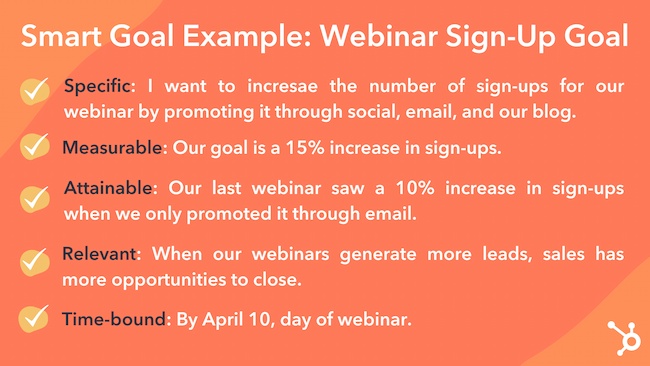
Every piece of content you create should align with your goals and contribute to your desired outcome. In essence, begin by defining your goals and then craft your content accordingly.
Create a buyer persona.
Developing a content strategy goes beyond mere content creation. It requires a deep understanding of your target audience, the tone you want to convey, and the channels to reach them. To create an impactful strategy, you must first know your audience, communicate effectively, and identify the most appropriate platforms to engage with them.
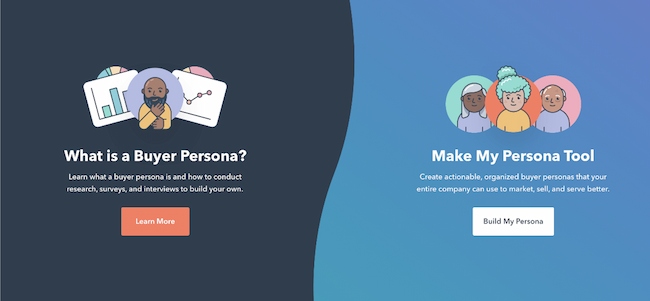
Crafting compelling inbound content requires making every reader feel personally addressed. Achieving this entails establishing an intimate connection with your website visitors, leads, and customers – understanding them like an old friend. Familiarize yourself with their obstacles, pain points, challenges, and fears. Equally important is comprehending their desired outcomes, dream solutions, and ultimate aspirations. Always bear in mind that you are marketing to individuals who crave a sense of connection. While it would be ideal to personally engage with each website visitor, it is simply not feasible.
The solution? Develop a buyer persona. This semi-fictional character serves as a representation of your target audience – those most likely to benefit from your message and become customers. Creating a buyer persona involves research, intuition, and refinement. However, the end result is a vivid portrayal of the person you wish to market to – someone who will eagerly consume your content. Uncertain where to begin? Utilize “Make My Persona” to construct your buyer persona.
Rely on the buyer’s journey.
When you experience a headache, the first instinct is to determine the cause. Maybe it’s due to dehydration, lack of caffeine, or an illness. Once you identify the problem, you move on to finding a solution. You consider options like drinking water, having an espresso, or taking medicine. Eventually, you make a choice: Evian or tap water? Starbucks or Peet’s Coffee? Aleve or Tylenol? Hopefully, the headache subsides and you can continue with your day.
This scenario resembles the buyer’s journey. Your prospects each follow a unique path towards finding a solution, which involves awareness, consideration, and decision stages. Since your prospects are at various stages of this journey, it’s crucial to tailor your content to appeal to each stage.
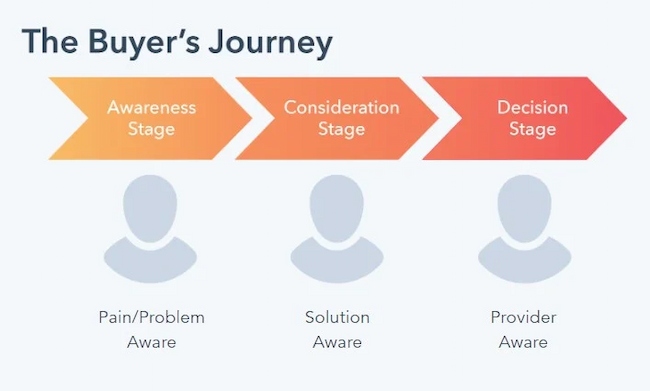
To ensure no visitors slip through the cracks and provide them with relevant and useful information, it is crucial to create content for each stage of the buyer’s journey. It’s important to select a format that is tailored to each stage, so that it resonates with your audience.
For instance, a new visitor in the awareness stage may not be interested in a live product demo. Instead, they would find value in reading a quick checklist or a blog post that helps them better understand their problem.
On the other hand, prospects in the decision stage don’t need to know about all the possible solutions. They require a consultation or demo that demonstrates how your product is the right solution for them. It’s essential to always meet your audience where they are in their journey.
Here is a guide to help you identify the best content formats for each stage of the buyer’s journey.
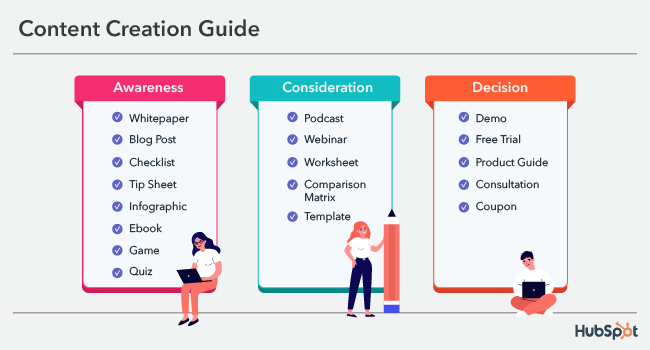
Perform a content audit.
Whether you’ve been creating content without a clear direction or following a strategy all along, every marketing department can benefit from a content audit. Just because you didn’t start with a well-defined strategy doesn’t mean your existing content won’t fit into one.
A content audit is simply taking inventory of the work you’ve already done and organizing it to align with your new content plan. This process may involve rewriting or identifying gaps that need to be filled to cater to your target audience and their journey stage.
Here’s how you can perform a content audit:
1. Gather all your content in a spreadsheet.
2. Create columns for target keywords, buyer persona, buyer’s journey stage, format, and main topic, and fill in this information for each content piece.
3. Include columns for key metrics such as page views, shares, and engagement.
4. Categorize each post (using highlights or another column) based on performance: those doing well, needing improvement, requiring rewriting, or suitable for merging with another post.
While a content audit may seem laborious, the manual effort will be worthwhile for increased traffic and leads. Moreover, it will provide you with a solid plan moving forward. If you find this process overwhelming, check out this post for further guidance.
Choose the right format.
Remember that buyer persona you created? You’re crafting content specifically for them. That means creating content in a format that your prospects will find easily digestible and enjoyable.
The format can vary – it could be a blog post, video, Slideshare, graphic, ebook, whitepaper, podcast, or any other format that sparks your creative mind. As long as it serves your persona, you’re on the right track.
Don’t feel confined to just one format for every piece of content you create. However, maintaining a consistent cadence is important. For example, a podcast series might be a fantastic marketing tactic, but if you lack the resources (and patience) to stick with it, then a blog might be a better choice.
Digital content creation involves selecting the most suitable format (usually digital) and using the right tools to publish and promote your content online.
When choosing your content format, keep these questions in mind as a guide:
- What stage of the buyer’s journey is this for?
- How easy is it for your audience to consume this content?
- Where does your persona spend their time online?
- What format can you create on a consistent basis?
- Are you able to produce this content at a quality level that’s competitive?
Choose capable content creators.
Now that you’re ready to dive into content creation, the first step is building a team of skilled content creators. Start by categorizing the type of content you want to create and identifying the specific roles needed for each. Here’s an example list to get you started:
– Blogs: Writer
– Social media posts: Social media coordinator
– Podcasts: Podcast host/producer
– Graphics: Graphic designer
– Webinars/Lead Magnets: Lead acquisition expert (content offer producer)
– Videos: Videographer/editor
As you can see, there are various types of content creators required to produce high-quality content that converts your audience into customers. While it’s common to have one person responsible for a lot of this content, expecting them to handle everything is unrealistic.
To streamline your content creation process, consider collaborating with freelancers, utilizing influencer marketing to expand your audience reach, and hiring one or more content strategists to help organize your content effectively. By doing so, you can ensure a well-rounded team effort and achieve optimal results.
Promote your content.
What’s the point of crafting exceptional content if it goes unnoticed? In an ideal scenario, hordes of people would flock to your website with every new post you publish. However, in reality, especially when you’re just starting out, you’ll need to actively entice and guide people to consume your content and engage with your online presence.
That’s why content promotion is just as crucial to your strategy as the content itself. Your promotion plan should be tailored to your target audience. Where do they spend their time online? What platforms do they frequent and at what times? How frequently do they prefer to see content from you? Moreover, it’s important to consider their preferred methods of consuming content and the email subject lines that capture their attention.
Remember, content promotion strategies differ across various mediums, and each requires a specific set of guidelines to follow.
Social Media
Social media serves as a powerful tool for nurturing relationships and promoting content. Achieving the right balance between self-promotion, sharing valuable information, and providing entertainment is key.
Platforms like Facebook, Twitter, Instagram, YouTube, and Snapchat offer excellent mediums to create and share relevant content. The crucial aspect lies in adapting the content to suit each platform’s unique characteristics.
Email Marketing
Email is a highly effective method of connecting with your audience, offering a multitude of opportunities to promote your content. This is because individuals on your email list have willingly subscribed to receive updates from you, ensuring the delivery of your messages. Moreover, by targeting segmented lists with tailored content, you can enhance your open rates and captivate readers with every email you send their way.
Paid Promotion
Pay-per-click (PPC) is an effective strategy to expand your content’s reach to new audiences by utilizing targeted, paid advertisements. These ads can be displayed on various platforms such as social media, search engines, or other websites.
Once you have identified your buyer persona, it is advisable to opt for the paid route to avoid wasting resources on uninterested parties. When you have successfully narrowed down your target audience, paid promotion can generate a significant return on investment (ROI).
Syndication
Promoting your content through reputable third-party channels is an excellent strategy for expanding your audience. Syndication exposes your brand to new eyes and wallets that may not have been reached through your own efforts alone.
Repurpose your content.
When you repurpose content, you’re leveraging the time and effort you invested in creating it by transforming it into different formats, expanding its reach and consumption potential. It’s akin to recycling, allowing you to allocate more time to engaging your audience rather than constantly creating new content.
For instance, that insightful blog post on marketing stats can effortlessly double up as a visually captivating infographic or even a compelling video. By exploring alternative formats, you can effectively maximize the impact of your information.
So, if you’ve crafted something in one format, take a moment to consider the myriad of other ways you can repurpose that valuable content to achieve equally impressive results.
Creating a Content Plan
Successful content is ubiquitous, yet its triumph lies in your knack for adapting it to its chosen medium. A one-size-fits-all approach falls short when it comes to posting across different platforms and even within platforms. The landscape of social media content differs from blog content, which in turn varies from website content. Thus, the art lies in tailoring your creation to resonate with your target audience wherever they may be. Now, let’s delve into some guidelines for effectively sharing content across diverse platforms.
Social Media Content
Crafting content for social media is an art worth mastering, considering the staggering 3.96 billion users across various platforms worldwide. Moreover, your social media followers are akin to warm leads – already fond of you and eager to hear your thoughts. With such an enthusiastic audience, engagement is within reach. To help you excel, here are some handy tips for creating captivating content on popular social channels.
1. Facebook
Facebook can be used to build micro-communities via Facebook Groups or to share with a mass audience on Facebook Pages. When it comes to sharing content, questions, and videos reap the most engagement.
2. Instagram
Instagram is best for sharing high-quality imagery and short videos with brief captions. Hashtags work well on this platform as long as they’re relevant to your account and business.
Instagram Stories has introduced a new way to engage with your followers, from quick polls to questions to real-time videos.
3. YouTube
YouTube has 1.3 billion users and counting. Users frequent this platform to watch content ranging from DIY videos to parodies.
Some of the most successful content on this platform are how-to guides, vlogs, product reviews, and educational videos.
Featured Resources
4. TikTok
TikTok has become one of the most popular social media platforms of our time. It’s best known for fun, short-form videos. It can be used to engage with your Millennial or Gen Z audience.
5. Twitter
Twitter best practices include short messages, supporting images, relevant hashtags, and retweets. And, of course, replies go a long way to win over your audience.
Website Content
Website content should focus on three things: your persona, your target keywords, and your solution.
Like your blog content, the copy on your website needs to guide visitors to your solution in a cohesive and natural way.
Think of web content like a map to your product.
Be careful not to turn visitors away through social media feeds and other distracting elements.
Once you‘ve attracted a potential customer, you must do everything you can to keep them there, and that’s the key function of your website content.
Blog Content
The primary objective of blog content is to bolster your business by attracting new visitors and cultivating potential customers. Although blog content is typically not directly associated with sales, its potential to drive revenue should not be underestimated. Research indicates that companies that prioritize blogging experience higher traffic and generate more leads compared to their counterparts who neglect this avenue.
The Content Creation Process
As marketers, our time is precious. We cannot afford to waste it on inefficient systems. That’s why we meticulously craft processes for every task we undertake.
We devise a system, implement it, fine-tune it until it’s optimized, and then repeat the process to achieve the desired results. Think about all the marketing campaigns you’ve executed – webinars, autoresponders, surveys – every single one of them followed a well-defined process. And content creation is no exception.
By following these steps, we eliminate the guesswork, allowing for more creative thinking and mental space. Let’s create content that captivates and resonates, while ensuring efficiency and effectiveness.
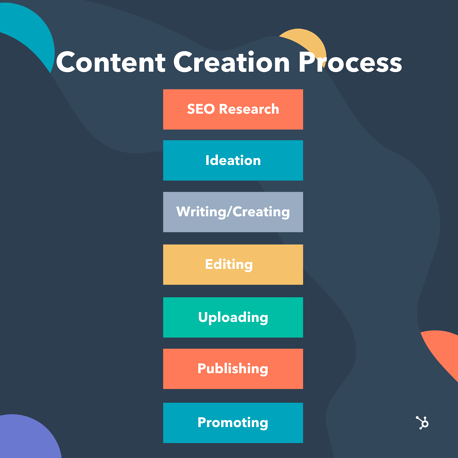
1. SEO Research
When you create your buyer persona, it gives you insights into potential topics and audience queries. This initial step is fantastic. However, it’s crucial to determine if these ideas can be scaled up to reach a larger audience. Writing a blog post for a single person would be ideal, but it would also be an inefficient use of your energy.
To assess the viability of your ideas, conduct SEO research, commonly known as keyword research. This will reveal the search volume for specific keyword phrases and help you decide if it’s worthwhile to create content around them. A practical approach to keyword research is to jot down questions that your persona may have based on their obstacles and goals. Subsequently, perform keyword research to gauge the search volume for those queries.
By optimizing your content creation process through effective keyword research, you can ensure that you are addressing topics that resonate with a broader audience.
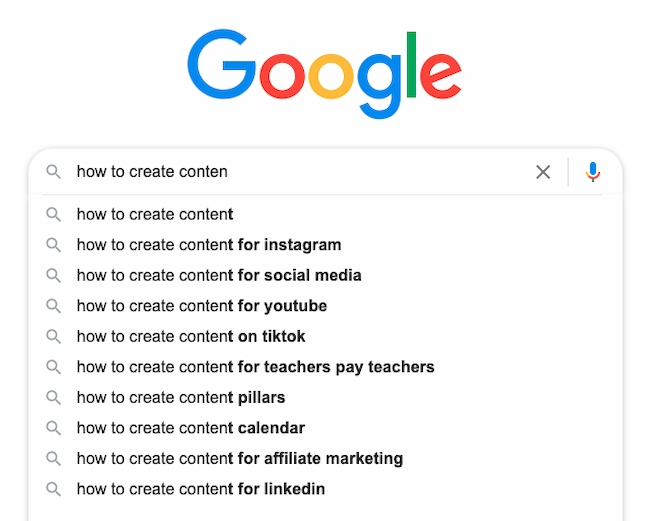
An effective strategy involves focusing on achievable keywords, which means selecting those with a suitable monthly search volume (MSV) and keyword difficulty that aligns with your domain authority.
If you’re a beginner blogger, aiming for high volume (and highly competitive) keywords won’t yield the best results.
Before we go any further, let’s detour into a quick-and-dirty SEO explanation:
Domain authority plays a crucial role in search engine rankings. It is determined by the number of external sites linking back to your content. To achieve this, it is vital to have a substantial collection of valuable content that can be referenced. As a result, the longer you produce high-quality content, the higher your domain authority will be.
This will make it easier to rank for competitive keywords and secure a spot on the first page of Google. If you haven’t reached that point yet, targeting long-tail, low-volume keywords with minimal difficulty (<50) is the best approach. Aim for search volumes between 200-1000 MSV. This strategy maximizes your chances of ranking for keywords and increasing your content’s visibility to a wider audience.
SEO lesson concluded. Back to our scheduled programming.
There are a few ways you could perform your keyword research:
- Use keyword research tools, like SEMRush or Moz Keyword Explorer.
- Type your keyword into a search engine and take note of the auto-filled queries.
- Check out the related searches section on search engine results pages (SERPs).
2. Ideation
Now that you have identified the keywords to target, it’s time to generate content ideas. According to HubSpot research, the most effective approach to organizing content is through topic clusters. This involves creating a comprehensive pillar page centered around a keyword, which then links to content focused on related subtopics (such as blog posts). This strategy enhances word choice, structure, readability, and eloquence while preserving the original meaning.
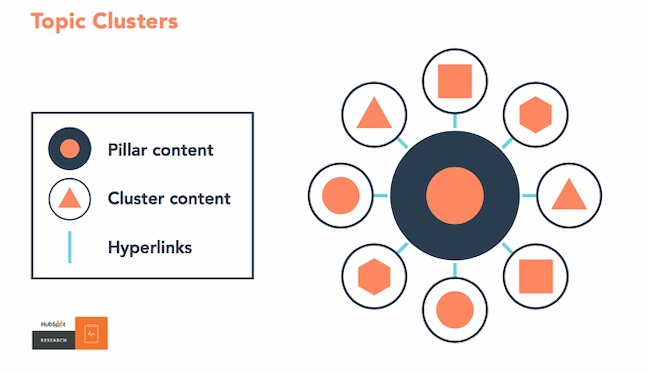
To illustrate this point, envision it like this: The topic cluster model facilitates brainstorming by providing a structured framework to follow. Start by crafting a comprehensive pillar piece centered around your main keyword, such as a guide to content creation. Then, complement it with shorter, supplementary content pieces like:
- Infographics
- Blog posts
- Templates
These strategies will enable your audience to delve deeper into the topic and effectively target long-tail keywords. If you’re struggling for inspiration, consider drawing ideas from books you’ve read, industry studies, your competitors’ websites, or related searches on SERPs. Once you’ve gathered all your ideas, you can craft a well-structured editorial calendar and commence content creation.
3. Writing
Your specific content creation strength might be videos or graphics or podcasts, but writing is the foundation of most content generation. Whatever content you make, the creation process follows some pretty similar guidelines.
Let’s go over some helpful tips for great content creation.
Write to your persona.
Use their voice, their euphemisms, even their humor to construct a piece that resonates.
Tell your audience why your content is important to them.
Use titles, meta descriptions, and other teasers to compel your audience to read your content. Put the benefit of your content right in the title to let them know why they should read it.
Create something unique.
Don‘t just regurgitate the information that’s already out there. Infuse a unique style or cite new research to emphasize your points.
Stick to one idea.
Then, use your content to reinforce it. Don’t confuse your reader by going on tangents or trying to explain multiple semi-related topics in a single piece.
Stay true to your voice.
Don’t try to impress your audience with eloquent prose or an expansive vocabulary if they don’t speak that way.
Be clear and concise.
You want your audience to relate to you and derive value from your content. So, don’t ask them to sift through jargon or confusing metaphors.
Leverage AI tools.
AI tools like HubSpot’s Free AI Content Writer can help you generate copy for content ranging from blog posts to social posts. You can use prompts about length, tone, and reading level to get the results you want.
If you are looking to generate content for campaigns specifically, HubSpot’s Campaign Assistant can help you — simply provide key details about your campaign.
Featured Resource
4. Editing
The way you edit your (or others’) work is a very subjective process. You may want to edit as you go, or you might wait a few days and review the work with fresh eyes.
You might care a great deal about grammar, or you might aim for a more colloquial piece.
Either way, there are a few things that you should definitely look out for as you refine your content, like active voice, clear language, short sentences, and plenty of whitespace. Consider having a colleague or manager review your work, too.
Some tools that will help you cut down on your editing time are Grammarly and Hemingway Editor.
5. Uploading
Now that your content is ready, you’ll need to put it somewhere that people can access it.
A content management system (CMS) is software that hosts digital content and allows you to display it on your website (or anywhere else on the web).
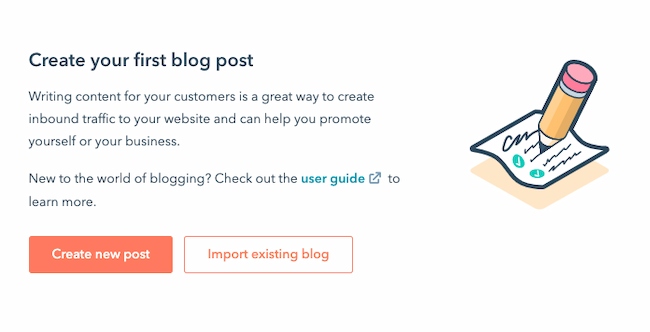
The benefit to a CMS is that it connects all of your content and stores it in one place. So, you can easily link to a landing page in your blog article or insert a content offer in an email.
Not only that, but you can analyze the results of all the content you created for a specific campaign (which can help with content audits). A CMS saves you from having a disjointed content marketing system.
For example, CMS Hub is home to our blog, where you get access to all of our great content and useful free offers.
6. Publishing
Publishing content is as simple as clicking a button. So, why include a section on it? Well, because it’s not always that simple.
You can publish your content immediately after uploading, or you can maximize its impact by waiting for an optimal time. If you‘re just starting out, then clicking publish right away probably won’t impact your audience too much.
But if you have committed to a regular publishing schedule, like delivering a new post every Wednesday, your audience will expect to see posts published on Wednesdays.
Something else to keep in mind is to publish according to trends or time-sensitive events. For example, if you create content about national holidays or current events, then you’ll want to publish those at specific times.
A CMS will allow you to schedule posts for a future date and specific time, so you can click, schedule, and forget.
7. Promoting Content
Finally, it‘s time to promote the content you’ve created. You can do this through various mediums including social media, email marketing, and even pay-per-click advertising.
To promote your content, think about what channels your audience is on. Are they on Facebook, Instagram, YouTube? Wherever it might be, it‘s important to meet them where they’re at and promote your content on that medium.
Additionally, collaborating with influencers or other brands will help you promote your content and reach more people.
Analyzing Your Content
The final, and arguably most important step in content creation is analyzing your content. Without data, you can‘t know what’s working or how to improve it.
There are several data points you could track when analyzing your content, so use your goals as a guide to set some parameters. Whatever you want to accomplish with your content will help you choose your metrics.
(Remember that initial goal we talked about?)
What you analyze is completely up to you, but here are some ideas for metrics to track:
Page Views
The number of users that visit your content. For blog posts this page views, but for any type of content, there is usually a “views” metric that will let you know how many times your content has been viewed and by how many unique users.
Organic Traffic
The amount of traffic that comes from search engines. This is unpaid traffic that you get from ranking high on Google or other search engines.
Bounce Rate
The percentage of visitors who leave your site after visiting only one page. This is an important metric to track because it can let you know that people are interested in clicking your posts, but then the content is immediately unsatisfying.
Conversion Rates
The percent of visitors that engage with a CTA — whether it’s a content offer, or filling out a form.
Engagement Rates
The number of people that interact with your content through likes, shares, comments, or in other ways.
Audience Growth
The new subscribers or leads that are generated from a piece of content.
Time On Page
The amount of time a user is on your page, whether it‘s a blog post, or a video (for video content this might be average watch time). It’s important to keep track of where users drop off.
Do they stay on the page long enough to read the post or consume the content?
Paid Campaigns
The amount of traffic that comes in from paid campaigns. If you sponsor posts on social media or pay for search engine ads, it’s important to track how much traffic comes from those campaigns.
If you need more tips on analyzing your content, check out this free HubSpot Academy course.
Content Creation Tools
While a CMS will help you manage your content, it won‘t help you create it. That’s where content creation tools come in handy. These are especially useful if you‘re artistically impaired, like me, or if you don’t have the capacity to hire help.
From GIFs to infographics, these content creation tools will help you look like a professional, regardless of what kind of content you’re making.
1. Make My Persona
MakeMyPersona is HubSpot’s own nifty tool that will walk you through the process of creating your buyer persona. You can generate a document to reference throughout your content creation process.
2. Blog Ideas Generator
This free tool from HubSpot can give you a full year of blog post ideas in just a few seconds. All you need to do is add a few nouns to get smart and relevant ideas for your blog.
This is super helpful, especially if you get stuck while putting together your editorial calendar.
3. Canva
Canva will help you create beautiful designs for any platform, from social ads to Facebook cover photos to infographics.
The software features aesthetically pleasing templates that you can customize with colors, images, and text … for free.
4. Giphy
Giphy The GIF has replaced emojis as a completely normal form of communication, and, therefore, an acceptable way to present content.
Giphy allows you to search millions of pre-created GIFs in their database or even create your own.
5. Vidyard
Vidyard is a video hosting platform that was made for marketers. The software allows you to customize your video by adding overlays, text, or CTA buttons, split test, and transcription, and it also has SEO features.
6. SurveyMonkey
SurveyMonkey is a leading survey creation platform. Why might you need such a thing? Because a good marketer knows that customer feedback is critical to an effective marketing campaign.
7. Anchor
Anchor is a podcasting tool for beginners. It’s free, allows you to record and store unlimited episodes, and you can easily upload to any third-party platform.
This is far from an exhaustive list of all the great content creation tools out there — this list of content marketing tools is even better!
Content Creation Examples
Now that you‘ve got a strong foundation for your content planning, strategy, creation, and analysis, it’s time to get inspired. These are some of our favorite examples of great content.
1. HubSpot Academy
HubSpot Academy offers free online training, teaching marketing, sales, and customer service. It offers a range of valuable certifications and its teachers are leading experts in their fields.
Many courses are short and self-paced, giving users a chance to learn topics in less than 30 minutes.
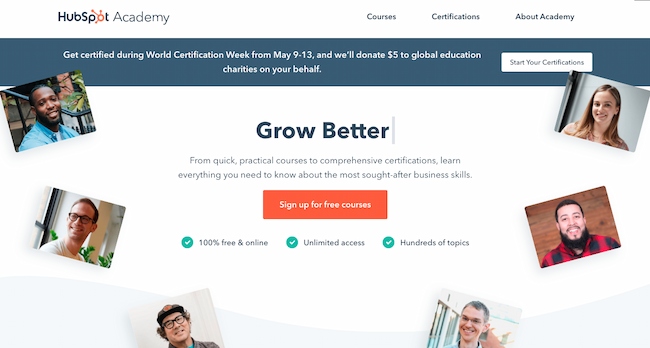
Why HubSpot Academy is great content creation: If you‘re new to marketing, HubSpot’s training is the top industry standard. These courses are also free, which makes them accessible for anyone who wants to learn.
Not every student will become a customer, but every student can experience the impact of these lessons. This means that every student has the potential to become a vocal advocate for the HubSpot brand.
2. Whiteboard Friday, Moz
For 10+ years, Moz has created content for Whiteboard Fridays. Rand Fishkin started this series, and members of the Moz team continue to teach weekly sessions about SEO and marketing.
In this video and blog series, an actual whiteboard takes center stage. The whiteboard features an outline of that Friday’s topic, and then the host breaks the topic down in more detail.
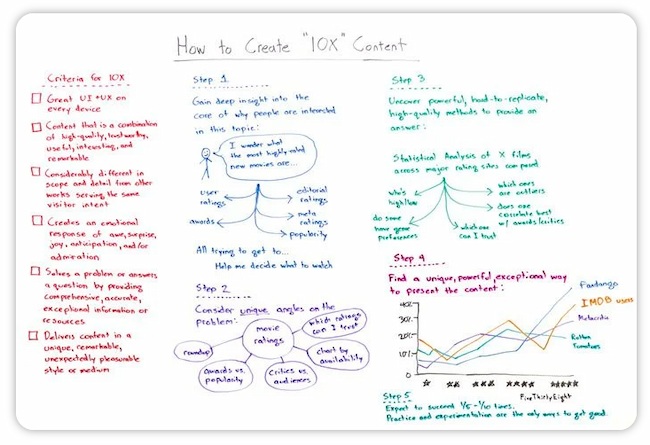
Why Whiteboard Fridays are great content creation: This series uses a simple and consistent visual tool to draw the audience in. They use that format to teach valuable ideas that a wide range of people can use.
This series also lends itself to many different formats.
The whiteboard outline can become an infographic, the video narration can be broadcast as a podcast, and the transcript from the video can become a blog for people who’d rather read than watch.
3. Home Buying Stories, NerdWallet
Whether you’re in Seattle, Des Moines, or Madison, it can be tough to buy a home. Besides the initial investment, homebuyers have a range of personal and financial questions they need to process.
This blog series interviews first-time homebuyers in different cities. Each post asks the same questions but also offers a unique window into the challenge of buying a home.
They cover the surprises, challenges, and gifts that come with this intense process.

Why Home Buying Stories are great content creation: Besides offering useful content with a personal touch, this series is an excellent strategy for growing traffic. The series offers a range of ideas to solve a common problem.

At the same time, it‘s a topic that’s a regular feature in local news, which means this content is often shared with new audiences.
4. Creative Routines, InfoWeTrust
This attractive infographic uses research to show the habits and schedules of creative thinkers from the past. It’s a stunning example of how an infographic can make data easier to understand and use.
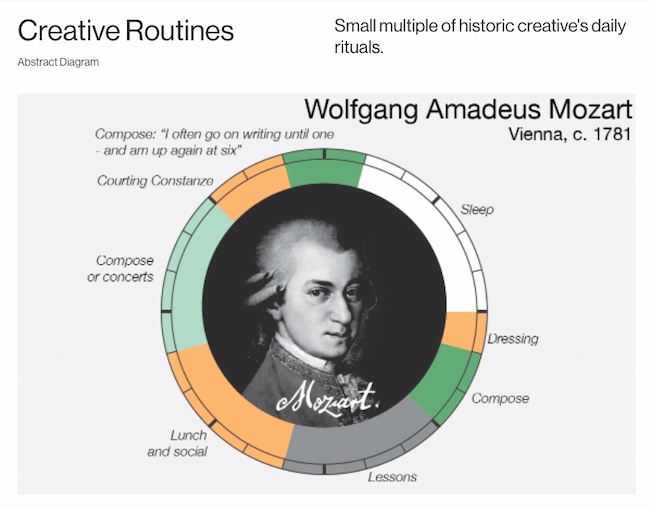
Why Creative Routines is great content creation: Besides showing the value of InfoWeTrust’s services, this content teaches us something. It makes data that could be difficult to understand easy to consume and remember.
It’s also super shareable. People shared this infographic in the press, on blogs, and on social media. This kind of mass appeal is how brands go viral.
5. Trending Quizzes, BuzzFeed
Raise your hand if you‘ve taken a Buzzfeed quiz. Quizzes are interactive, so they get your audience involved. They’re also games, and gamification is more popular than ever.
Past quizzes from this dynamic brand include:
- Correctly Answering These 11 Logic Questions Means You Have A High IQ
- If You‘ve Read Over 28 Of These Books From Back In The Day, You’re A Proper Bookworm
- If You Did 23/31 Things On This List As A Teen, You Were Definitely A Rebel
Each quiz is unique and appeals to a different buyer persona. At the same time, these quizzes are fun, quick, and easy to share.
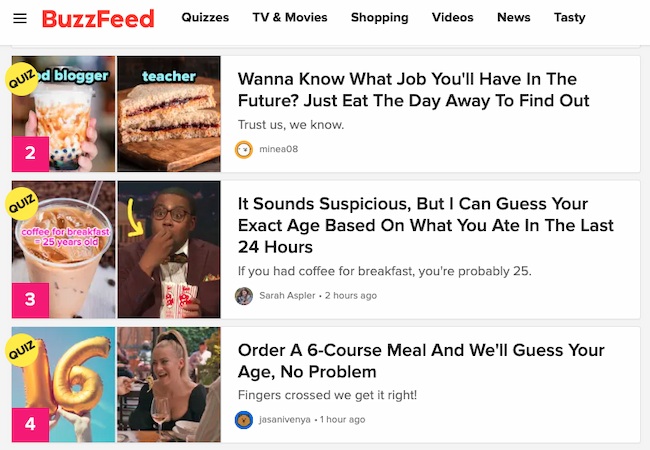
Why Buzzfeed quizzes are great content creation: They created design templates that made it easy for people to create and share their own quizzes.
Not everyone is great with Photoshop, and these templates made quizzes great to look at. By appealing to both the mind and the eye, they broadened the appeal of their quizzes.
But what’s most important is that people talk about quizzes. When someone takes a quiz, Buzzfeed makes it easy to share the results, which continues to expand that conversation.
Start Creating
Content creation is an iterative process that pays off tremendously with your audience.
Once you have the content creation process down, you’ll be able to generate creative work that not only delights your audience but also grows your business.
26 of the Best Free Stock Photo Sites to Use in 2024
11 Skills You Need in the AI Era


